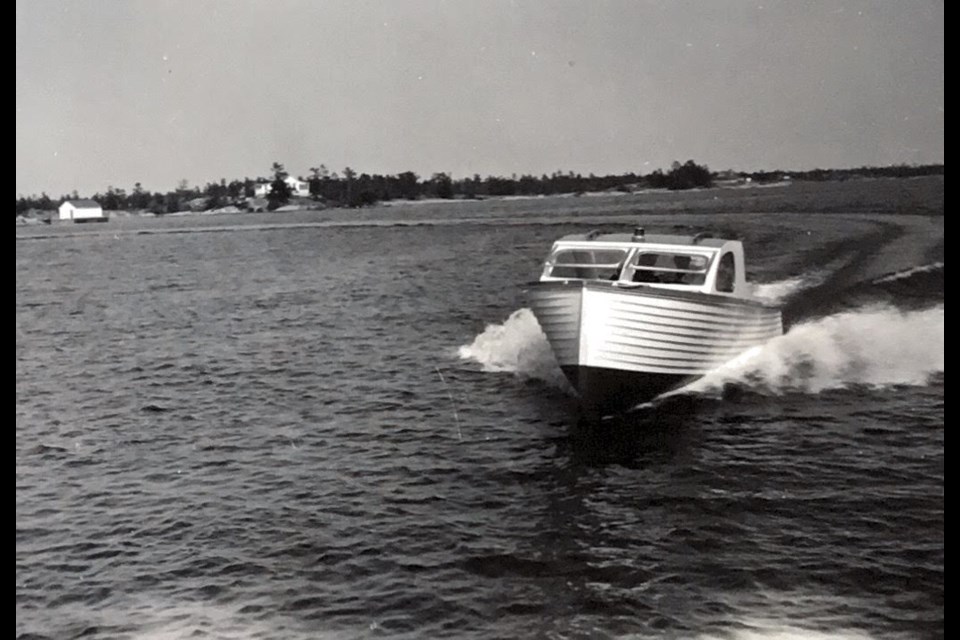As people start opening their cottages, and putting their boats back in the water very few will be wooden boats these days.
Not so long ago, wooden boats were one of the only options.
“Fiberglass was not an option for boats back then,” says Tom Ulrichsen about his father’s company, the Norse Boat and Ski Company.
The Norse Boat and Ski Company was a local boat building business and marina based in Penetanguishene the 1940s until sometime in the 1960s.
Not only did this small but mighty boat builder provide life boats to the Canadian Navy during the Second World War, but they also outfitted the Norwegian Army with skis.
During WWII, after the fall of Norway to the Nazis, the King, key members of the government and military left Norway in June 1940 aboard that HMS Devonshire that later sought safe harbour in England.
The government-in-exile then set up a base in North America for their remaining air force members, and Toronto Island Airport was their base of operations.
No one in the Ulrichsen family knows how either of those contracts were secured. However, the railway came right into Penetang and passed right by the back of the store, so it made shipping the boats easy.
“Information sources are a lot different now than they were then,” laughs John Ulrichsen about how the family has kept some the company’s history alive.
The name of the business, Norse Boat and Ski Company, came from the Ulrichsen’s Norwegian roots. True to their Viking roots — lovingly nudged and winked at — the Ulrichsens enjoyed boating and exploring in the summer and skiing in the winter.
Maybe that’s why the Norwegian army reached out, the brothers joke.
The boats they made ranged from something they lovingly called a sea flea at about 10-12 feet long to watercraft up to 45-feet long.
Wooden boats are sought out because they were handcrafted, designed and built with care. The wood insulates from cold, heat and acts as a sound barrier.
The Norse Boat and Ski Company remains a well-known name among vintage wooden boat enthusiasts. The family learned about a restoration project on one of the company’s larger boats a few years ago.
“We visited the place where we used to lived, and about half an hour away was a boat restoration place. We saw something indicating they were doing this [restoration project]. We visited and explained who we were,” says Tom referring to his older brother John.
The boat was a 32-34 foot craft.
“It’s identical to the original right down to the cabinets,” says Tom.
A restoration project like that demonstrates the excellence of the construction of the boats, says John.
“If I see a Norse Boat, I recognize it right away, and I always talk to the owners and explain who I am,” says John, proud of his family’s craftsmanship.
“There’s a definite difference between a wooden boat from that time and a fibreglass boat,” explains Tom.
When fiberglass boats came into production in the 1970s, their lighter weight, and the speed with which they could be produced quickly made wooden boats less common.
The Norse Boat and Ski Company closed their doors in the 1960s.
“The last couple [of boats] were made as personal boats. One for my father and one for another uncle,” says Tom, whose father Eric and uncle Jan co-owned the company.
Eric Ulrichsen, John and Tom’s father, worked at the Gidley Boat Company in Penetanguishene for a number of years before starting his own boat company with their uncle Jan.
“I remember seeing designs, and drawings of the hulls of the boats,” recalls Tom. “My father designed all the hulls.
“Some of these boats are still in use in Midland, Penetang, Georgian Bay today,” says Tom.
What makes these wooden boats so sought after these days is the style. They were unique.
“You’re either a wooden boat fan or a plastic boat fan,” says Tom.
“My father always said wooden boats were better because of the natural buoyancy of wood,” says John.
What keeps the memories of their family’s boat-building business afloat are the brothers’ stories about their time working there during the summers.
The two shared a few laughs about having to repaint the bottoms of the boats every year in enclosed spaces, upside down, with a paintbrush dripping with a kind of paint that would likely be frowned upon today.
“Almost all of the boats needed to be repainted every year,” recalls Tom.
There may have been a moment when a boat took on some water by accident too. John recalls an incident when he and his father repaired a propeller and forgot to replace the shaft. After putting the boat back in the water, John started to take it to the dock and heard a noise, pulled over, and realized the boat was taking on water.
“It was only about a one-inch hole, so there was no harm done,” says John, explaining that he plugged the hole with his hand until help could come.
He laughs about it now, but says it wasn’t funny at the time. Such is the way with any well told story.
Like well-told stories, these hand-crafted boats stand the test of time.
“What makes them long-lasting is their structure and how well they are made,” John explains.
Next time you see a wooden boat, stop to ask a few questions about who made the boat, and maybe learn a bit of local history. You may find a Norse Boat built by hands that helped support the war effort for more than one country’s forces during the Second World War.



